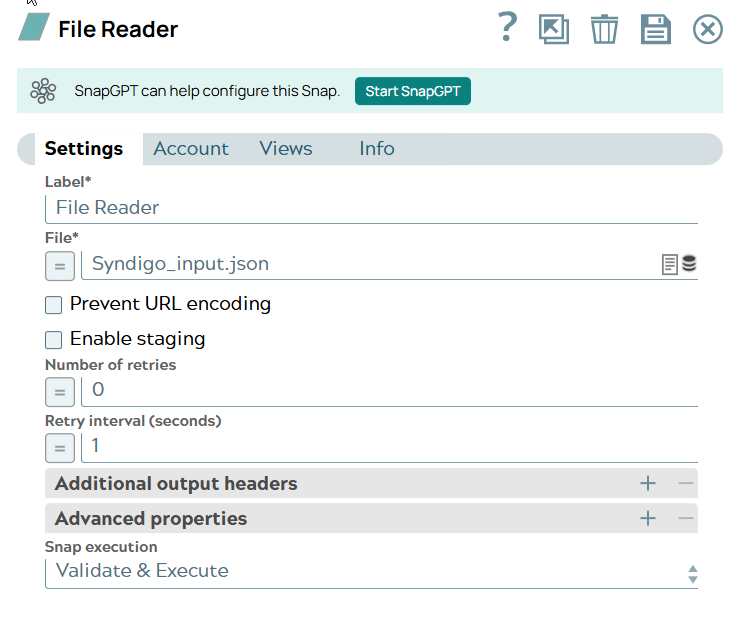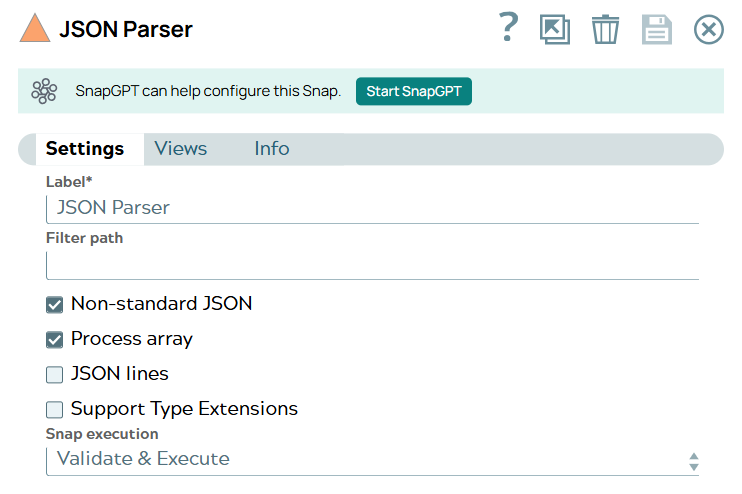This example pipeline demonstrates how to filter an RSJSON input from Syndigo server
based on a few requirements.
The filter requirements are: Find those products from the 'thing' domain where the locale is 'fr-FR',
UOM separator '@@' context is 'Sri Lanka', channel is 'India', and have documents attached.
Create another RSJSON with these list of products entities.
-
Configure the
File Reader
Snap as follows:
- File: <The RSJSON file name from Syndigo>.
- You can let the other fields in this Snap remain with their default values/states.
On validation, the Snap displays the information on the entities it has fetched, in the Table preview.
The JSON preview displays the metadata of the Snap's output.
| File Reader Snap configuration |
File Reader Snap output |
|
|
-
Connect the JSON Parser Snap.
- File: <The RSJSON-formatted file name from Syndigo>.
- You can let the other fields in this Snap remain with their default values/states.
On validation, the Snap displays the information on only those entities that match the Snap configuration.
The JSON preview displays the metadata of the Snap's output.
| JSON Parser Snap configuration |
JSON Parser Snap output |
|
|
-
Connect the RSJSON Parser Snap to extract entities list for a
specific domain and entity type. Configure the Snap as follows:
Tip:
Replicating the configurations from the screenshot below (with expressions enabled) will yield the same
results as configuring the Snap with the following values (without enabling expressions).
- Domain: thing
- Entity: product
- Locale: fr-FR
- UOM Separator: @@
- Include context: Checkbox selected.
- Context settings (two rows):
- Context name:refcountrylist
- Context value:Sri Lanka
and
- Context name:refchannel
- Context value:India
- Related entities:
- Related entity:hasdocuments-document
On validation, the Snap displays the simplified JSON version of the matching entities' information out of the JSON Parser Snap's output.
| RSJSON Parser Snap configuration |
RSJSON Parser Snap output |
|
|
-
Connect the RSJSON Formatter Snap to format the resultant entities list
into the RSJSON format based on the domain's model information. Configure the Snap as follows:
- Entity: product
- Validate input: Checkbox selected.
- UOM Separator: ##
On validation, the Snap displays the resultant entities information in the RSJSON format.
| RSJSON Parser Snap configuration |
RSJSON Parser Snap output |
|
|
-
Connect a Document to
Binary Snap to convert each incoming document from the
RSJSON Formatter Snap into a binary form so it can be written to a file using the
File Writer
Snap.
This File Writer Snap output will contain the filtered entities information in the RSJSON format.
To successfully reuse pipelines:
- Download and import the pipeline into SnapLogic.
- Configure Snap accounts as applicable.
- Provide pipeline parameters as applicable.











